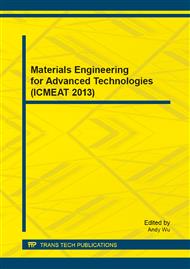[1]
Brennen, C. B. Cavitation and Bubble Dynamics, Oxford University Press, New York, New York (1995).
Google Scholar
[2]
Kyoung-Su Im, Seong-Kyun Cheong , Christopher F. Powell , Ming-chia D. Lai, Jin Wang. Unraveling the Geometry Dependence of In-Nozzle Cavitation in High-Pressure Injectors. SCIENTIFIC REPORTS, 2013(6).
DOI: 10.1038/srep02067
Google Scholar
[3]
BRENNEN C E. Cavitation and bubble.
Google Scholar
[1]
ROTH H, GIANNADAKIS E, GAVAISES M, et al. Effect of Multiinjection strategy on cavitation development in diesel injector nozzle holes /2005 SAE World, Michigan, (2005).
DOI: 10.4271/2005-01-1237
Google Scholar
[4]
R.D. Lockett, L. Liverani, D. Thaker, M. Jeshani, N.P. Tait. The characterisation of diesel nozzle flow using high speed imaging of elastic light scattering. Fuel 106 (2013) 605–616.
DOI: 10.1016/j.fuel.2012.10.065
Google Scholar
[5]
P.G. Aleiferis, Z.R. van Romunde. An analysis of spray development with iso-octane, n-pentane, gasoline, ethanol and n-butanol from a multi-hole injector under hot fuel conditions. Fuel, 105 (2013) 143–168.
DOI: 10.1016/j.fuel.2012.07.044
Google Scholar
[6]
P.G. Aleiferis, J. Serras-Pereira, A. Augoye, et al. Effect of fuel temperature on in-nozzle cavitation and spray formation of liquid hydrocarbons and alcohols from a real-size optical injector for direct-injection spark-ignition engines. International Journal of Heat and Mass Transfer, 53(2010).
DOI: 10.1016/j.ijheatmasstransfer.2010.06.033
Google Scholar
[7]
SOU A, HOSOKAWA S, TOMIYAMA A. Cavitation in nozzles of plain orifice atomizers with various length-to-diameter ratios. Atomization and Sprays, 20(2010) : 513-524.
DOI: 10.1615/atomizspr.v20.i6.30
Google Scholar
[8]
SUH H K, LEE C S. Effect of cavitation in nozzle orifice on the diesel fuel atomization characteristics. International Journal of Heat and Fluid Flow, 29(2008): 1001-1009.
DOI: 10.1016/j.ijheatfluidflow.2008.03.014
Google Scholar
[9]
Seung Hyun Yoon, Su Han Park, Chang Sik Lee. Experimental investigation on the fuel properties of biodiesel and its blends at various temperatures. Engery and Fuels, 22(2008) 652-656.
DOI: 10.1021/ef7002156
Google Scholar
[10]
RAYLEIGH L. On the pressure developed in a liquid during the collapse of a spherical cavity. Phil Mag, 34(1917): 94-98.
Google Scholar
[11]
Zhixia He, Wenjun Zhong, Qian Wang, Zhaochen Jiang, Zhuang Shao. Effect of nozzle geometrical and dynamic factors on cavitating and turbulent flow in a diesel multi-hole injector nozzle. International Journal of Thermal Sciences, 70 (2013).
DOI: 10.1016/j.ijthermalsci.2013.03.008
Google Scholar


